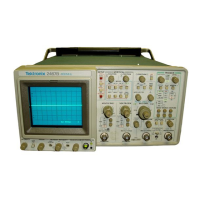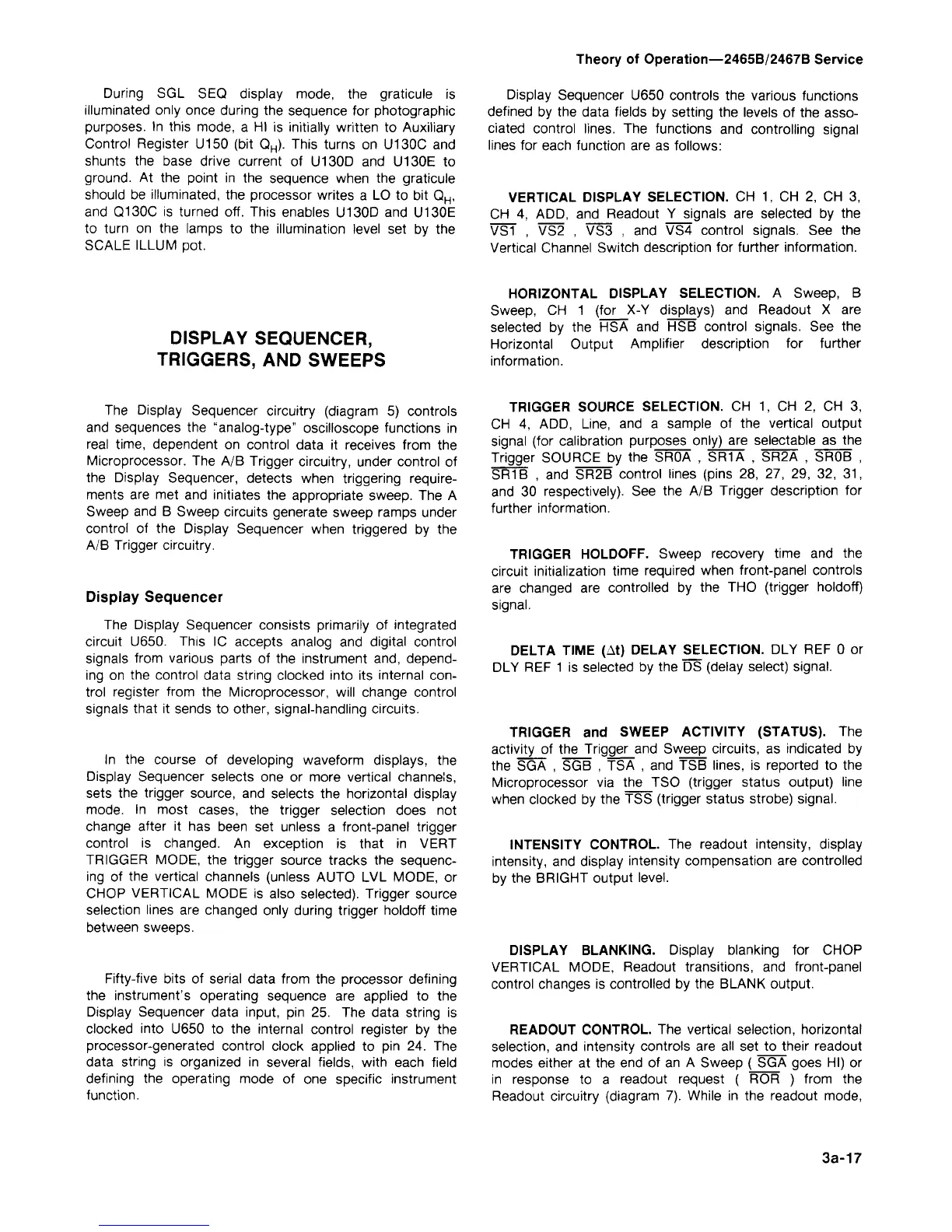Theory of Operation—2465B/2467B Service
During SGL SEQ display mode, the graticule is
illuminated only once during the sequence for photographic
purposes. In this mode, a HI is initially written to Auxiliary
Control Register U150 (bit Q
H
). This turns on U130C and
shunts the base drive current of U130D and U130E to
ground.
At the point in the sequence when the graticule
should be illuminated, the processor writes a LO to bit Q
H
,
and Q130C is turned off. This enables U130D and U130E
to turn on the lamps to the illumination level set by the
SCALE ILLUM pot.
DISPLAY SEQUENCER,
TRIGGERS, AND SWEEPS
The Display Sequencer circuitry (diagram 5) controls
and sequences the "analog-type" oscilloscope functions in
real time, dependent on control data it receives from the
Microprocessor. The A/B Trigger circuitry, under control of
the Display Sequencer, detects when triggering require-
ments are met and initiates the appropriate sweep. The A
Sweep and B Sweep circuits generate sweep ramps under
control of the Display Sequencer when triggered by the
A/B Trigger circuitry.
Display Sequencer
The Display Sequencer consists primarily of integrated
circuit U650. This IC accepts analog and digital control
signals from various parts of the instrument and, depend-
ing on the control data string clocked into its internal
con-
trol register from the Microprocessor, will change control
signals that it sends to other, signal-handling circuits.
In the course of developing waveform displays, the
Display Sequencer selects one or more vertical channels,
sets the trigger source, and selects the horizontal display
mode.
In most cases, the trigger selection does not
change after it has been set unless a front-panel trigger
control is changed. An exception is that in VERT
TRIGGER MODE, the trigger source tracks the sequenc-
ing of the vertical channels (unless AUTO LVL MODE, or
CHOP VERTICAL MODE is also selected). Trigger source
selection lines are changed only during trigger holdoff time
between sweeps.
Fifty-five bits of serial data from the processor defining
the instrument's operating sequence are applied to the
Display Sequencer data input, pin 25. The data string is
clocked into U650 to the internal control register by the
processor-generated control clock applied to pin 24. The
data string is organized in several fields, with each field
defining the operating mode of one specific instrument
function.
Display Sequencer U650 controls the various functions
defined by the data fields by setting the levels of the asso-
ciated control lines. The functions and controlling signal
lines for each function are as follows:
VERTICAL DISPLAY SELECTION. CH 1, CH 2, CH 3,
CH 4, ADD, and Readout Y signals are selected by the
VST , VS2 , VS3 , and VS4 control signals. See the
Vertical Channel Switch description for further information.
HORIZONTAL DISPLAY SELECTION. A Sweep, B
Sweep, CH 1 (for X-Y displays) and Readout X are
selected by the HSA and HSB control signals. See the
Horizontal Output Amplifier description for further
information.
TRIGGER SOURCE SELECTION. CH 1, CH 2, CH 3,
CH 4, ADD, Line, and a sample of the vertical output
signal (for calibration purposes only) are selectable as the
Trigger SOURCE by the SROA , SR1A , SR2A , SROB ,
SR1B , and SR2B control lines (pins 28, 27, 29, 32, 31,
and 30 respectively). See the A/B Trigger description for
further information.
TRIGGER HOLDOFF. Sweep recovery time and the
circuit initialization time required when front-panel controls
are changed are controlled by the THO (trigger holdoff)
signal.
DELTA TIME (At) DELAY SELECTION. DLY REF 0 or
DLY REF 1 is selected by the DS (delay select) signal.
TRIGGER and SWEEP ACTIVITY (STATUS). The
activity of the Trigger and Sweep circuits, as indicated by
the SGA , SGB , TSA , and TSB lines, is reported to the
Microprocessor via the TSO (trigger status output) line
when clocked by the TSS (trigger status strobe) signal.
INTENSITY CONTROL. The readout intensity, display
intensity, and display intensity compensation are controlled
by the BRIGHT output level.
DISPLAY BLANKING. Display blanking for CHOP
VERTICAL MODE, Readout transitions, and front-panel
control changes is controlled by the BLANK output.
READOUT CONTROL. The vertical selection, horizontal
selection,
and intensity controls are all set to their readout
modes either at the end of an A Sweep ( SGA goes HI) or
in response to a readout request ( ROR ) from the
Readout circuitry (diagram 7). While in the readout mode,
3a-17

